In order to nail your driving test, you need to know the most common mistakes learners make on the day, so you have an idea of what to avoid.
Thousands of practical tests are carried out every year in the UK, which means there’s a large percentage of fails, all of which are more than likely caused by some of the following mistakes:
Failing to check your blind spot when reverse parking
Efficient reverse parking takes a huge amount of skill and patience, so once you know how, don’t forget the basic things that an examiner will look for:
- Look around you, and make sure you are fully aware of all your surroundings. Don’t think you have to rush through this to please an examiner.
- Failure to check your blind spot is dangerous as you could miss cyclists or cars and cause a collision.
Stalling at traffic lights
Traffic lights can easily catch you out, especially if you are nervous during your test, so just break it down:
- Whilst stationary at a traffic light, prepare yourself for driving on, so the moment the lights turn to amber, you are ready to start accelerating.
- Don’t rush to move off, because this will likely result in the engine cutting out and you stalling, potentially causing the car behind you to bump into you.
- Remember to always stop before the white line, so your view is not impaired and you are not at risk of an accident.
Poor signalling
You can easily rack up several minors due to poor signalling, which can confuse other drivers. Remember the basics:
- Forgetting to give a signal at all, as well as last minute signals, causes confusion and accidents as other drivers are not clear on what you intend to do.
- If you drive on without signalling to other drivers, or you give the wrong signal, you could endanger lives.
- It’s also very important to turn off your signal immediately upon completion of your manoeuvre, so your intentions are clear. For example, if you wish to turn right, make sure that you turn off your indicator once you’ve completed the turn. Otherwise, drivers and pedestrians will assume that you intend to turn right again.
Poor steering
- The easiest way to change gear is to take one hand off the steering wheel, change gear and then bring your hand back.
This will keep you steady in your lane and will ensure you don’t drift and hit the kerb.
You should try and keep two hands on the wheel as much as possible, to avoid losing control. - Accurate steering is vital to avoid accidents, so the sooner you master it, the better.
Poor judgement at junctions
There are two types of junctions you may come across during your test: closed or open. Poor judgement will most likely result in a major fail and a serious accident.
- A closed junction means that you do not have full view of the road ahead. Ease out slowly, checking each direction as much as possible.
- An open junction means that there’s nothing in your eye-line to block your view of the road ahead.
Here you must look left, right, left and right again. Once you are satisfied everything is clear, pull out onto the road.
Speeding
- Your test is likely to be a combination of main road and residential driving, so always check the speed limit.
- Don’t be in a rush to finish your test as you don’t want to fail by doing 35 in a 30mph zone after nailing everything else!
Not checking your mirrors
- Check your mirrors at every opportunity, and ensure you do so before making any signal or manoeuvre.
- Just take a quick look to ensure you are completely aware of everything around you.
But don’t over use your mirrors, otherwise they will distract you and you will lose track of the road ahead.





